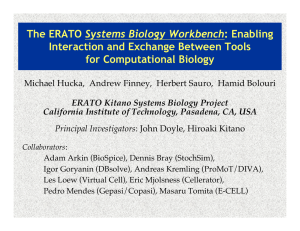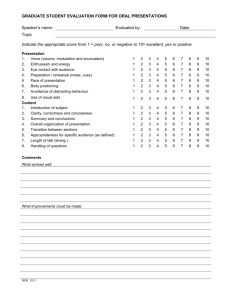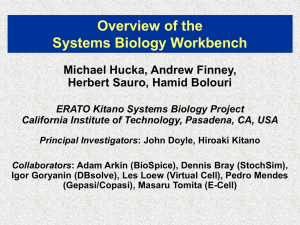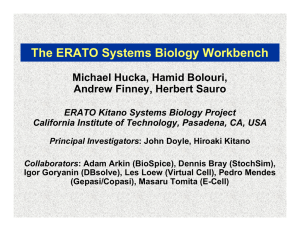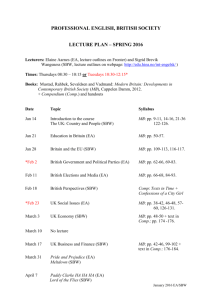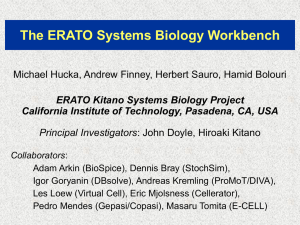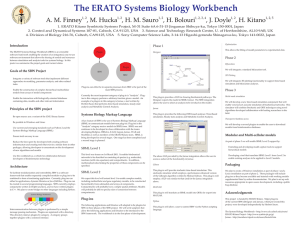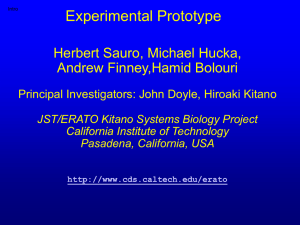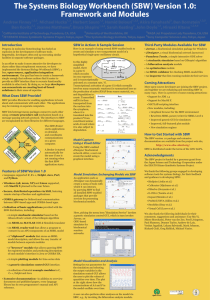Systems Biology Workbench Interaction and Exchange Between Tools for Computational Biology
advertisement
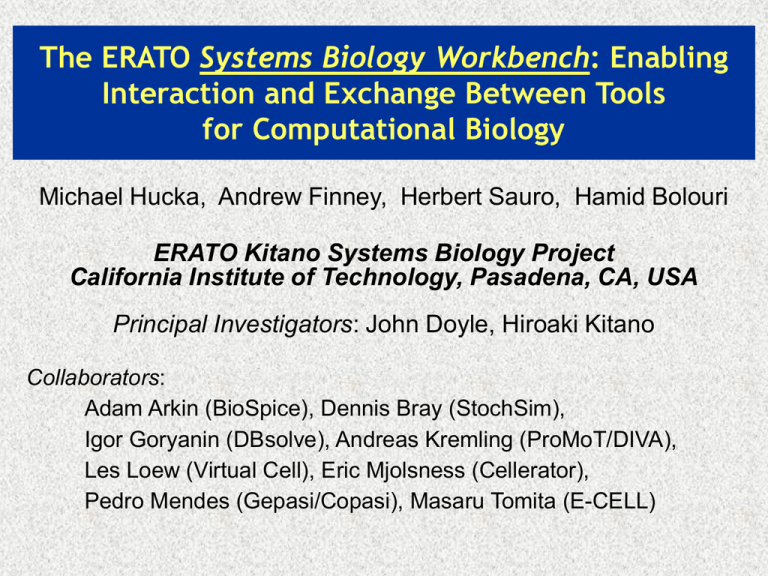
The ERATO Systems Biology Workbench: Enabling
Interaction and Exchange Between Tools
for Computational Biology
Michael Hucka, Andrew Finney, Herbert Sauro, Hamid Bolouri
ERATO Kitano Systems Biology Project
California Institute of Technology, Pasadena, CA, USA
Principal Investigators: John Doyle, Hiroaki Kitano
Collaborators:
Adam Arkin (BioSpice), Dennis Bray (StochSim),
Igor Goryanin (DBsolve), Andreas Kremling (ProMoT/DIVA),
Les Loew (Virtual Cell), Eric Mjolsness (Cellerator),
Pedro Mendes (Gepasi/Copasi), Masaru Tomita (E-CELL)
Motivations
• Observation: proliferation of software tools
• No single package answers all needs
– Different packages have different niche strengths
– Strengths are often complementary
• No single tool is likely to do so in the near future
– Range of capabilities needed is large
– New techniques ( new tools) evolve all the time
• Researchers are likely to continue using multiple
packages for the foreseeable future
• Problems with using multiple packages:
– Simulations & results often cannot be shared or re-used
– Duplication of software development effort
2
Project Goals & Approach
• Develop software & standards that
– Enable sharing of simulation & analysis software
– Enable sharing of models
• Goal: make it easier to share tools than to reimplement
• Two-pronged approach
– Develop a common model exchange language
• SBML: Systems Biology Markup Language
– Develop an environment that enables tools to interact
• SBW: Systems Biology Workbench
3
Systems Biology Markup Language (SBML)
• Biochemical network models
X0
K1· X0
k 2 · S1
X1
k 3 · S1
X2
S1
• A model is described using a list of components:
– Beginning of model definition
» List of unit definitions (optional)
» List of compartments
» List of species
» List of parameters (optional)
» List of rules (optional)
» List of reactions
– End of model definition
4
Systems Biology Workbench (SBW)
• Simple framework for enabling application
interaction
– Free, open-source (LGPL)
– Portable to popular platforms and languages
– Small, simple, understandable
Script
Interpreter
Visual
Editor
Stochastic
Simulator
SBW
Database
Interface
ODE-based
Simulator
• From the user’s perspective, SBW is invisible
5
SBW From the User’s Perspective
QuickTime™ and a
BMP decompressor
are needed to see this picture.
6
From the Programmer’s Perspective
• Simple, lightweight, message-passing architecture
– Cross-platform compatible & language-neutral
• Modules are separately-compiled executables
– A module defines services which have methods
– SBW native-language libraries provide APIs
• C, C++, Java, Delphi, Python available now
• … but can be implemented for any language
• SBW Broker acts as coordinator
– Remembers services & modules that implement them
– Starts modules on demand
• Broker itself is started automatically
– Notifies modules of events (startup, shutdown, etc.)
7
The SBW Broker’s Registry
• Registry records information about modules
– Module name
– How to start module
– What services the module provides
– The categorization of those services
• Hierarchy of service categories
Service
Categories
(Interface
Hierarchy)
Services
(Interfaces)
8
Example of Service Categories
Service
Simulation
Methods
void
void
void
void
loadModel(string SBML)
setStartTime(double time)
setEndTime(double time)
run()
+
ODESimulation
void setIntegrator(int method)
void setNumPoints(int num)
9
Service Categories Group Applications
• Clients can be written to interact with classes of
modules in a generic way
interface
void
void
(Java)
void
void
void
void
}
ODESimulation {
loadModel(string SBML)
setStartTime(double time)
setEndTime(double time)
run()
setIntegrator(int method)
setNumPoints(int num)
• User menus can be grouped by categories
• Need help from community to define common
categories of interfaces
10
Why?
• Why not use CORBA?
– Complexity, size, compatibility
– Could not find fully-compliant open-source CORBA ORB
that supports all required programming languages
– SBW scheme does not require a separately compiled IDL
– But: planning to have gateway between CORBA & SBW
• Why not use SOAP or XML-RPC?
– Performance, data type issues, implementation quality
• Why not Java RMI?
– Java-specific
• Why not COM?
– Microsoft-specific, low portability
11
SBW Status & Future
• Beta release: http://www.cds.caltech.edu/erato
–
–
–
–
Java, C, C++, Delphi, Python libraries
Windows & Linux
Developer’s manuals & tutorials, examples
Modules:
• SBML Network Object Model
• Optimization module
• MATLAB model generator
• Stochastic simulator
• Plotting module
• Jarnac ODE simulator
• JDesigner visual editor
• Spring 2002: production release 1.0
–
–
–
–
Perl and C# libraries
Secure distributed operation
CORBA gateway
More modules: Bifurcation analysis, Gillespie “Tau-Leap”
12
